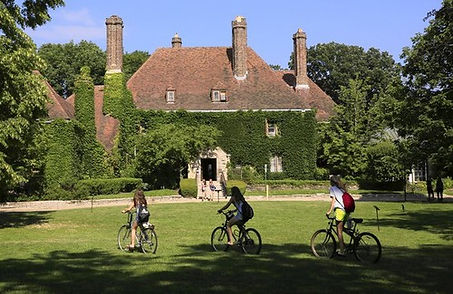
Harley History
Harley History
The Harley Lyman Clarke Mansion, its accessory structures, and the property are located adjacent to Lighthouse Beach and situated within the Northeast Evanston Historic District. The grounds are unique in that four ecological systems exist here: water, dune, prairie and forest.
It is part of the Lighthouse Landing campus of public properties at the intersection of historic Sheridan Road and Central Street in north Evanston. The grounds are situated atop the point of land, jutting into Lake Michigan, that early French explorers called Grosse Point. Historical accounts name this site as a landing place for Father Jacques Marquette in 1674. In 1829, Archange Marie Ouilmette, a Potowatami woman, was awarded 1280 acres of land here.
.jpeg)
As trade developed, numerous shipwrecks occurred and an important early lighthouse, the Grosse Point Lighthouse, was built in 1873. Today the lakefront complex includes the Lighthouse, the Lighthouse keeper's house, two fog houses, the Harley Clarke mansion, its coach house and grounds, and five acres of park including Noah’s Playground for All, Lighthouse Landing Park and Lighthouse Beach. The Lighthouse, supported in recent years by a non-profit, was added to the National Register of Historic Places in 1976 and made a National Historic Landmark in 1998.
The historic Harley Clarke House, designed in the French Eclectic style by Richard Powers, is situated on beachfront property and features gardens by pioneering landscape architect Jens Jensen. The house and coach house were listed as contributing structures in the application to the National Park Service designating the historic district.
.jpeg)
Harley Lyman Clarke and his wife, Hildur, while living on Chase Avenue in Rogers Park, hired Powers to design the three-story, brick lakefront home in Evanston. It was completed in 1927 at 2603 Sheridan Road, just north of the historic Grosse Point Light Station.
The 37,700 square foot home featured a spacious glass conservatory, a ballroom, a basement "rumpus room," and coach house. It was probably the last of the 1920s mansions to be built in Evanston before the stock market crashed.
Renowned landscape architect Jens Jensen designed the grounds which still feature the original limestone pond or grotto, distinctive signature council ring (known as the fire pit), and walkway. Alfred Caldwell, creator of the Chicago Lily Pool in Lincoln Park, worked with Jensen during construction of the grounds and referred to that time as one of his fondest memories. The mansion, valued at $500,000 in 1938, was the first in the Chicago area to win an art commission award.
At one time Clarke’s fortune was estimated at $60 million. He was a powerful utilities magnate, serving as President of Utilities Power and Light in the years leading up to the Great Depression. He was also civic minded; he donated $300,000 to form the Chicago Civic Shakespeare Society.
An undated glossy real estate brochure, presumably from the 1940s, states that motion picture equipment was housed on the mansion's third floor. Clarke created a state of the art media room in the ballroom after investing heavily in Fox Studios, serving as the president after buying out founder William Fox during the Depression. He also owned the General Theatre chain. He pioneered the use of film for education leading to the formation of the Society for Visual Education.
Sadly, Clarke and his wife were victims of the Great Depression and after a long struggle with creditors, were forced to sell the property in 1949 to the Sigma Chi Fraternity for its national headquarters.
In 1964, visionaries on Evanston’s City Council purchased the property and beachfront from the fraternity, highlighting the importance of creating a public park, beach and a public building. Shortly after the purchase, the City leased the Harley Clarke House to the Evanston Art Center for $1 per year "for the purpose of promoting art and culture for the benefit of the entire Evanston community." For over 50 years, the building housed the Evanston Art Center, a cultural destination for people of all ages.
Today the mansion and surrounding gardens are the keystone of the four-part lakefront complex that includes Noah’s Playground for All, Lighthouse Beach, the Grosse Point Lighthouse and the mansion. With the Evanston Art Center relocating in 2015 to a newer, more centrally located facility, Harley Clarke is currently vacant and in need of repair and restoration. It is the only publicly owned house between Howard Street and Isabella.
As stewards of a new vision, it's time to act, to contribute, and to revitalize this unique space. Make history with us as we seek to create Evanston Community Lakehouse & Gardens.

